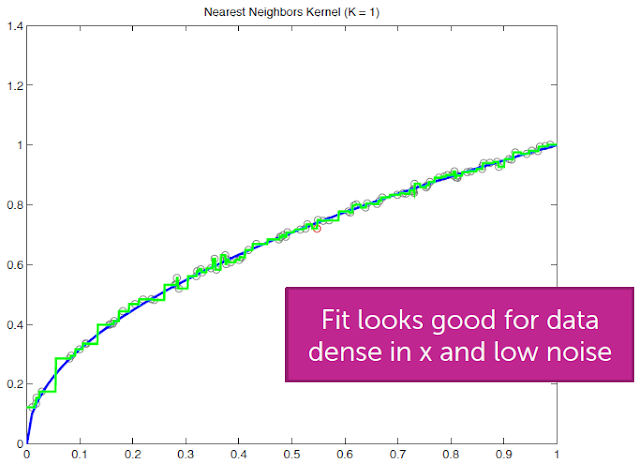Classification
- Binary classification problem
- y只考慮是0或1,即y∈{0,1}
- 0又稱為negative class,可用"-"表示
- 1又稱為positive class,可用"+"表示
Hypothesis Representation
\begin{align*}0 \leq h_\theta (x) \leq 1 \end{align*}
- 新的形式稱為Sigmoid Function 或Logistic Function
\begin{align*}& h_\theta (x) = g ( \theta^T x ) \newline \newline& z = \theta^T x \newline& g(z) = \dfrac{1}{1 + e^{-z}}\end{align*}
- $h_\theta(x)$代表的是output為1的機率
- 假設$h_\theta(x)=0.7$,代表有70%的機率output會是1
- 而output是0的機率就是1-70%=30%
Decision Boundary
- 為了要把結果做0跟1的分類,可以把hypothesis function的output轉譯成如下:
\begin{align*}& h_\theta(x) \geq 0.5 \rightarrow y = 1 \newline& h_\theta(x) < 0.5 \rightarrow y = 0 \newline\end{align*}
- 從前面Sigmoid Function的圖可知當z > 0時,g(z) >= 0.5
- 若z為$\theta^T X$則代表:
\begin{align*}& h_\theta(x) = g(\theta^T x) \geq 0.5 \newline& when \; \theta^T x \geq 0\end{align*}
- 所以
\begin{align*}& \theta^T x \geq 0 \Rightarrow y = 1 \newline& \theta^T x < 0 \Rightarrow y = 0 \newline\end{align*}
- Decision Boundary就是用來區分y=0跟y=1區域的那條線
Cost Function
- 若Logistic Function使用Linear Regression的Cost Function,則會是波浪的形狀有很多Local Optima
- Logistic Regression的Cost Function如下
\begin{align*}& J(\theta) = \dfrac{1}{m} \sum_{i=1}^m \mathrm{Cost}(h_\theta(x^{(i)}),y^{(i)}) \newline & \mathrm{Cost}(h_\theta(x),y) = -\log(h_\theta(x)) \; & \text{if y = 1} \newline & \mathrm{Cost}(h_\theta(x),y) = -\log(1-h_\theta(x)) \; & \text{if y = 0}\end{align*}
- 當y=1時會得到$J(\theta)$跟$h_\theta (x)$的圖
- 當y=0時會得到$J(\theta)$跟$h_\theta (x)$的圖
- 整理如下:
\begin{align*}& \mathrm{Cost}(h_\theta(x),y) = 0 \text{ if } h_\theta(x) = y \newline & \mathrm{Cost}(h_\theta(x),y) \rightarrow \infty \text{ if } y = 0 \; \mathrm{and} \; h_\theta(x) \rightarrow 1 \newline & \mathrm{Cost}(h_\theta(x),y) \rightarrow \infty \text{ if } y = 1 \; \mathrm{and} \; h_\theta(x) \rightarrow 0 \newline \end{align*}
Simplified Cost Function and Gradient Descent
- 我們可以把上面的Cost()整合成一條式子
- $\mathrm{Cost}(h_\theta(x),y) = - y \; \log(h_\theta(x)) - (1 - y) \log(1 - h_\theta(x))$
- 整體的Cost Function如下表示:
- $J(\theta) = - \frac{1}{m} \displaystyle \sum_{i=1}^m [y^{(i)}\log (h_\theta (x^{(i)})) + (1 - y^{(i)})\log (1 - h_\theta(x^{(i)}))]$
- 用vector的方式實作如下:
\begin{align*} & h = g(X\theta)\newline & J(\theta) = \frac{1}{m} \cdot \left(-y^{T}\log(h)-(1-y)^{T}\log(1-h)\right) \end{align*}
Gradient Descent
- Gradient Descent的表示式跟Linear Regression一樣
\begin{align*} & Repeat \; \lbrace \newline & \; \theta_j := \theta_j - \frac{\alpha}{m} \sum_{i=1}^m (h_\theta(x^{(i)}) - y^{(i)}) x_j^{(i)} \newline & \rbrace \end{align*}
- 用vector的方式實作如下:
$\theta := \theta - \frac{\alpha}{m} X^{T} (g(X \theta ) - \vec{y})$
Advanced Optimization
- 除了Gradient Descent之外有其他更好的方法
- Conjugate gradient
- BFGS
- L-BFGS
- 但是建議不要自己實做這些複雜的演算法,而是找已經最佳化過的Library
- 我們需要提供一個Function去計算下面兩個結果
\begin{align*} & J(\theta) \newline & \dfrac{\partial}{\partial \theta_j}J(\theta)\end{align*}
- 首先寫一個單一Function回傳這兩個結果
function [jVal, gradient] = costFunction(theta)
jVal = [...code to compute J(theta)...];
gradient = [...code to compute derivative of J(theta)...];
end
options = optimset('GradObj', 'on', 'MaxIter', 100);
initialTheta = zeros(2,1);
[optTheta, functionVal, exitFlag] = fminunc(@costFunction, initialTheta, options);
Multiclass Classification: One-vs-all
- 當類別超過兩類時,定義 y = {0,1...n}
- 把這個問題分成n+1個Binary Classification Problem,將最大的結果當成預測值
\begin{align*}& y \in \lbrace0, 1 ... n\rbrace \newline& h_\theta^{(0)}(x) = P(y = 0 | x ; \theta) \newline& h_\theta^{(1)}(x) = P(y = 1 | x ; \theta) \newline& \cdots \newline& h_\theta^{(n)}(x) = P(y = n | x ; \theta) \newline& \mathrm{prediction} = \max_i( h_\theta ^{(i)}(x) )\newline\end{align*}
Regularization
- 為了避免overfitting,可以在cost function中加上對weight的懲罰,所以cost function改寫如下:
- $min_\theta\ \dfrac{1}{2m}\ \sum_{i=1}^m (h_\theta(x^{(i)}) - y^{(i)})^2 + \lambda\ \sum_{j=1}^n \theta_j^2$
- Regularized Linear Regression
- Gradient Descent
- 演算法改寫如下,要注意的是並沒有對$\theta_0$做懲罰
\begin{align*} & \text{Repeat}\ \lbrace \newline & \ \ \ \ \theta_0 := \theta_0 - \alpha\ \frac{1}{m}\ \sum_{i=1}^m (h_\theta(x^{(i)}) - y^{(i)})x_0^{(i)} \newline & \ \ \ \ \theta_j := \theta_j - \alpha\ \left[ \left( \frac{1}{m}\ \sum_{i=1}^m (h_\theta(x^{(i)}) - y^{(i)})x_j^{(i)} \right) + \frac{\lambda}{m}\theta_j \right] &\ \ \ \ \ \ \ \ \ \ j \in \lbrace 1,2...n\rbrace\newline & \rbrace \end{align*}
- 在經過整理後如下:
- $\theta_j := \theta_j(1 - \alpha\frac{\lambda}{m}) - \alpha\frac{1}{m}\sum_{i=1}^m(h_\theta(x^{(i)}) - y^{(i)})x_j^{(i)}$
- 由於$1 - \alpha\frac{\lambda}{m}$ 永遠會小於1,而後面的項目跟沒做regularization前一樣,所以weight會減小的範圍就決定在$1 - \alpha\frac{\lambda}{m}$
- Normal Equation
- 式子改寫如下:
\begin{align*}& \theta = \left( X^TX + \lambda \cdot L \right)^{-1} X^Ty \newline& \text{where}\ \ L = \begin{bmatrix} 0 & & & & \newline & 1 & & & \newline & & 1 & & \newline & & & \ddots & \newline & & & & 1 \newline\end{bmatrix}\end{align*}
- 前面提過若m<n則$X^TX$是不可逆的,但在改寫後$X^TX$ + λ⋅L是可逆的。
- Regularized Logistic Regression
- 和Regularized Linear Regression的方法一樣


















































